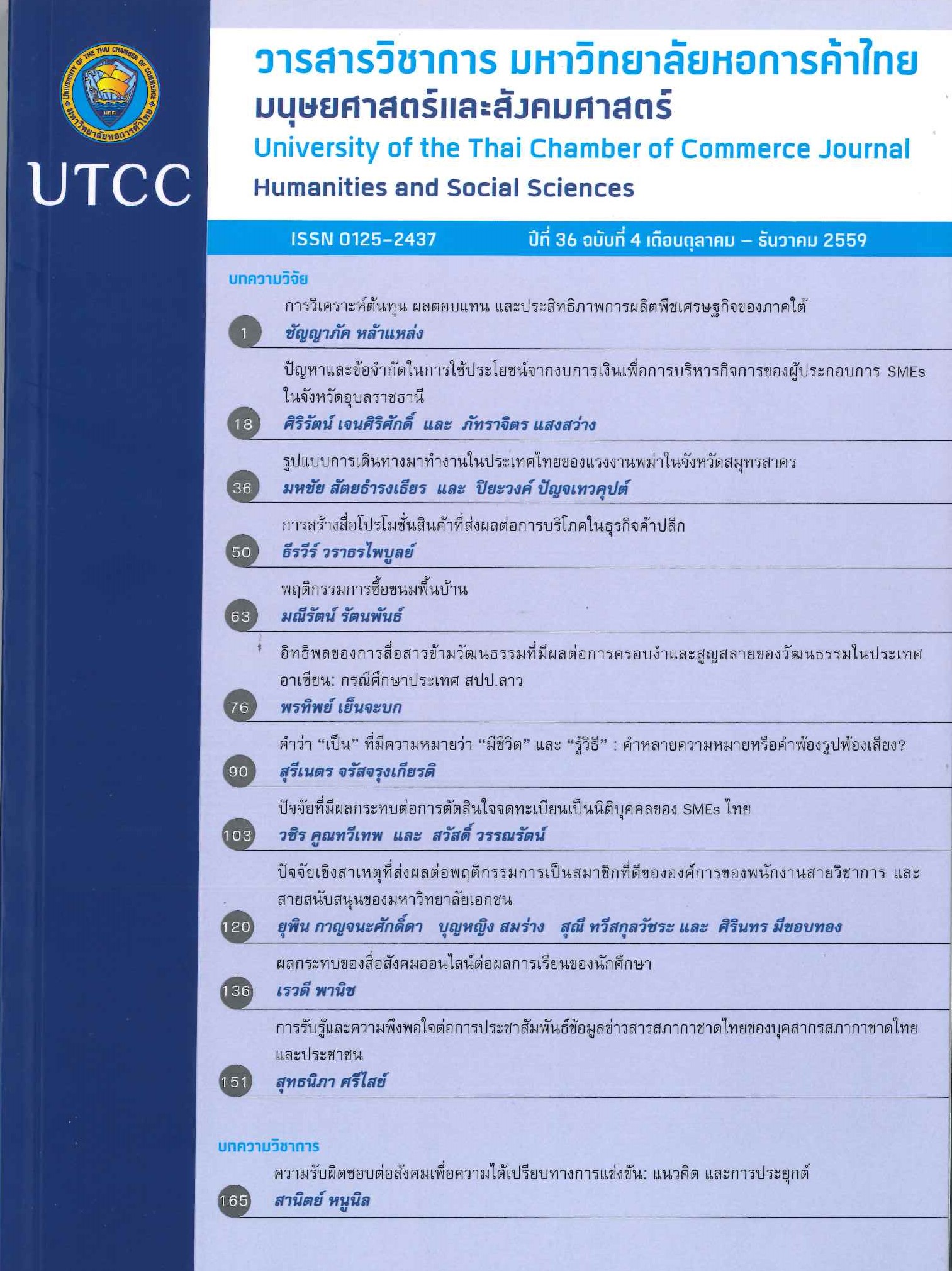Corporate Social Responsibility for Competitive Advantage: Concept and Application
Main Article Content
Abstract
Due to highly intense competitiveness at present, consumer behavior is changing, including higher awareness of social and environmental problems of stakeholders, so organizations must search for new strategies to build competitive advantage. Social responsibility is another strategy that has been used to create competitive advantage for organizations. Because the implementation of social responsibility contributes to better relationship between organizations and various stakeholders, which also has positive impact on factors, such as customer satisfaction, employee engagement, good relationship with community and operational cost savings in the long term. It also supports sustainable development.
Article Details
ลิขสิทธิ์ของบทความ
ผลงานที่ได้รับการตีพิมพ์ถือเป็นลิขสิทธิ์ของมหาวิทยาลัยหอการค้าไทย ห้ามมิให้นำเนื้อหา ทัศนะ หรือข้อคิดเห็นใด ๆ ของผลงานไปทำซ้ำ ดัดแปลง หรือเผยแพร่ ไม่ว่าทั้งหมดหรือบางส่วนโดยไม่ได้รับอนุญาตเป็นลายลักษณ์อักษรจากมหาวิทยาลัยหอการค้าไทยก่อน
References
Computer Firms, 1945-2000.” European Management Journal 22,5: 517-531.
Baker, M. 2015. Corporate Social Responsibilities - What does it mean? [Online].Available: http://www.mallenbaker.net/csr/definition.php
Barney, J. B. 1991. “Firm Resource and Sustained Competitive Advantage.” Journal of Management 17,1: 99-120.
Baron, D. P. 2001. “Private politics, Corporate Social Responsibility and Integrated Strategy.” Journal of Economics and Management Strategy 10,1: 7-45.
Bhattacharyya, S. S. 2010. “Exploring the Concept of Strategic Corporate Social Responsibility for an Integrated Perspective.” European Business Review 22,1: 82-102.
Carroll, A. B. 1979. “A Three-Dimensional Conceptual Model of Corporate Performance.” Academy of Management Review 4,4: 497-505.
Carroll, A. B. 1991. “The Pyramid of Corporate Social Responsibility: Toward the Moral Management of Organizational Stakeholders.” Business Horizon 34,4: 39-48.
Dahlsrud, A. 2006. “How Corporate Social Responsibility is Defined: An Analysis of 37 Definitions.” Corporate Social Responsibility and Environment Management 15,1: 1-13.
Danthamrongkul, W. 2003. Management. Bangkok: Thirdwave Education. (in Thai).
วิทยา ด่านธำรงกูล. 2546. การบริหาร. กรุงเทพมหานคร: เธิร์ดเวฟ เอ็ดดูเคชั่น.
Du, S., Bhattacharya, C. B., and Sen, S. 2007. “Reaping Relational Rewards from Corporate Social Responsibility: the Role of Competitive Positioning.” International Journal of
Research in Marketing 24,3: 224-241.
European Commission. 2015. What is CSR? [Online]. Available: http://ec.europa.eu/social/main.jsp?catId=331
Frey, M., et al. 2014. “Corporate Social Responsibility and Competitiveness within SEMs of the Fashion Industry: Evidence from Italy and France.” Sustainability 32,6: 872-893.
Friedman, M. 1970. “The Social Responsibility of Business to Increase its Profits.” The New York Time Magazine 13: 32-33.
Garaihy, E. H. W., Mobarak, M. K. A., and Albahussain, A. S. 2014. “Measuring the Impact of Corporate Social Responsibility Practices on Competitive Advantage: A Mediation Role of Reputation and Customer Satisfaction.” International of Journal of Business and Management 9,5: 109-124.
Iszatt-White, M., and Sauanders, C. 2014. Leadership. Oxford: Oxford Press.
Jones, T. M. 1995. “Instrumental Stakeholder Theory: A Synthesis of Ethics.” The Academy of Management Review 20,2: 404-437.
Karagozoglu, N., and Lindell, M. 2000. “Environmental Management: Testing the Win-Win Model.” Journal of Environmental Planning and Management 43,6: 817-829.
Khunthongjan, S. 2008. “The Relationship between Corporate Governance Characteristics and Competitive Potentialities of Small and Medium-sized Enterprises in the Northeast of Thailand.” Journal of Ubolratchathani University 10,2: 112-127. (in Thai).
สุภาวดี ขุนทองจันทร์. 2551. “ความสัมพันธ์ระหว่างคุณลักษณะบรรษัทภิบาลกับศักยภาพในการแข่งขันของวิสาหกิจขนาดกลางและขนาดย่อมในเขตภาคตะวันออกเฉียงเหนือ.” วารสารวิชาการมหาวิทยาลัยอุบลราชธานี 10,2: 112-127.
Marín, L., Rubio, A., and Maya, D. R. S. 2012. “Competitiveness as a Strategic Outcome of Corporate Social Responsibility.” Corporate Social Responsibility and Environmental
Management 19, 364-376.
McWilliams, A., and Siegel, D. 2011. “Creating and Capturing Value: Strategic Corporate Social Responsibility, Resource Based Theory and Sustainable Competitive Advantage.” Journal of Management 37,5: 1480-1495.
Mostovicz, I., Kakabadse, N., and Kakabadse, A. 2009. “CSR: The Role of Leadership in Driving Ethical Outcomes.” Corporate Governance 9,4: 448-460.
Network NGO-Business Partnership. 2009. Research Paper: CSR Development in Thailand. Bangkok: The Network NGO-Business Partnership. (in Thai).
เครือข่ายความร่วมมือระหว่างภาคธุรกิจและภาคประชาสังคมเพื่อการพัฒนาที่ยั่งยืน. 2552. รายงาน วิจัยเรื่องการพัฒนา CSR ในประเทศไทย. กรุงเทพมหานคร: เครือข่ายความร่วมมือระหว่างภาคธุรกิจและภาคประชาสังคมเพื่อการพัฒนาที่ยั่งยืน.
Porter, M. E. 1985. Competitive Advantage: Creative and Sustaining Superior Performance. New York: The Free Press.
Porter, M. E., and Kramer, M. R. 2006. “Strategy and society: The Link between Competitive Advantage and Corporate Social Responsibility.” Harvard Business Review 84, 78-92.
Russell, N. S., and Millar, H. H. 2104. “Exploring the Relationships among Sustainable Manufacturing Practice, Business Performance and Competitive Advantage: Perspectives from a Developing Economy.” Journal of Management and Sustainability 4,3: 37-53.
Securities and Exchange Commission. 2015. Corporate Social Responsibility (CSR) [Online]. Available: http://www.sec.or.th/TH/RaisingFunds/EquityDebt/Pages/link-Laws_Regulations/CSR.aspx (in Thai).
สำนักงานคณะกรรมการกำกับหลักทรัพย์และตลาดหลักทรัพย์. 2558. ความรับผิดชอบต่อสังคม (CSR) [ออนไลน์]. เข้าถึงจาก: http://www.sec.or.th/TH/RaisingFunds/EquityDebt/Pages/link-Laws_Regulations/CSR.aspx
Stock Exchange of Thailand. Social Responsibility Center. 2013. Corporate Social Responsibility for Sustainable Development. Bangkok: Social Responsibility Center, Stock Exchange of Thailand. (in Thai).
ตลาดหลักทรัพย์แห่งประเทศไทย. สถาบันธุรกิจเพื่อสังคม. 2556. ความรับผิดชอบต่อสังคมเพื่อการพัฒนาที่ยั่งยืน. กรุงเทพมหานคร: สถาบันธุรกิจเพื่อสังคม ตลาดหลักทรัพย์แห่งประเทศไทย.
Tiyou, S. 2003. Strategic Management. Bangkok: Thammasat University. (in Thai).
เสนาะ ติเยาว์. 2546. การบริหารเชิงกลยุทธ์. กรุงเทพมหานคร: มหาวิทยาลัยธรรมศาสตร์.
Tollin, K., and Jones, R. 2007. “Marketing Logics for Competitive Advantage. European Journal of Marketing 43,3/4: 523-550.
Vilanova, M., Lozano, J. M., and Arenas, D. 2009. “Exploring the Nature of the Relationship Between CSR and Competitiveness.” Journal of Business Ethics 87,1: 57-69.
Virakul, B. 2015. “Global Challenges, Sustainable Development, and their Implications for Organizational Performance.” European Business Review 27,4: 430-446.
Waddock, S. 2004. “Parallel Universes: Companies, Academic, and Citizenship: Towards Corporate Accountability.” Business and Society Review 110,2: 191-212.
Wiriyapipat, N. 2009. “Trend of CSR: Gearing towards ISO 26000.” University of the Thai Chamber of Commerce Journal 29,3: 193-205. (in Thai).
นิภา วิริยะพิพัฒน์. 2552. “ก้าวทันกระแส CSR: ความพร้อมสู่มาตรฐาน ISO 26000.” วารสารวิชาการมหาวิทยาลัยหอการค้าไทย 29,3: 193-205.
World Business Council for Sustainable Development. 2015 . Corporate Social Responsibility (CSR) [Online]. Available: http://www.wbcsd.org/work-program/business-role/previous-work/corporate-social-responsibility.aspx

